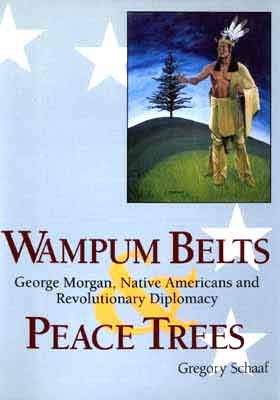 Wampum Belts and Peace Trees
Wampum Belts and Peace Trees(Apparently out of print—We're working on it.)
 Wampum Belts and Peace Trees
Wampum Belts and Peace Trees
George Morgan, Native Americans and Revolutionary Diplomacy
Gregory Schaaf's book was published in 1990 by Fulcrum Publishing. The copy in the Archive Library was a gift from Jack Weatherford. It has been called "a new interpretation of early American history."
Did you know that there was almost a fourteenth state? Did you know that Native Americans held the balance of power between the colonists and the British at the time of the American Revolution. Did you know that the first treaty between the U.S. and the American First Nations was signed in 1776, and included an ambassador to the tribes. This is really interesting stuff, and is based on original materials.
When his book was published, Dr. Schaaf was the Coordinator of the Native American Studies Program and an Associate Professor at Mankato State University in Minnesota.
The dust jacket for the original hardcover edition said:
"Only a few months before independence was proclaimed on July 4, 1776, the Continental Congress appointed George Morgan Indian agent in the Middle Department and ordered him westward on a mission of peace. The Indian nations had the military might to sway the outcome of the American Revolution, and the British and the Americans competed to win the favor of influential Indian leaders.
"One chief, the Delaware White Eyes, sought liberty, justice and equal rights for Native American people. He personally appealed to the members of the Continental Congress to bridge the chasm between the cultures and to maintain friendly diplomatic relations. The political stakes were high: the future survival of his nation as well as the security of millions of other Indian people rested precariously on the balance of power between the British forces and the American colonies.
"For his part, to "keep Congress informed" George Morgan established an elaborate intelligence network spread from Canada in the north to the Gulf Coast in the south, and from the Mississippi River to the Atlantic seaboard. His friends and allies, both Indian and white, apprised him of the latest frontier developments.
"Recently, Schaaf discovered Morgan's personal journal and letterbook, containing information on the first United States-Indian peace treaty in 1776. Using these documents, as well as letters exchanged between Morgan and George Washington, John Hancock and other notables of the period, Schaaf for the first time tells the full story of the relationship between the American rebels and the Native Americans. Morgan's journal, which chronicles his career as an Indian agent, shows how he risked his life and earned respect from powerful Indian nations.
"In 1976, Susannah Morgan, whose late husband was the great-great-grandson of Colonel Morgan, suggested to Schaaf that he take a look at some documents in her trunk. He discovered the 73 missing pages of Colonel George Morgan's 200-year-old journal. The Los Angeles Times called the discovery 'the historical find of the bicentennial." People magazine wrote, 'If there is such a thing as a hot young historian, Gregory Schaaf is it.' Since then, he has made an extensive study of the Morgan papers and their role in American history. Now, for the first time, Dr. Schaaf provides us with a new interpretation of early American history, based on significant discoveries in George Morgan's journal."
"A spectacular cache of Revolutionary era papers and journals." — National
Geographic
"Dr. Schaaf is widely respected as the discoverer of the Morgan Papers, the most important collection of American documents to be uncovered in decades. Featuring unpublished letters written by George Washington, Thomas Jefferson and John Hancock, the papers of America's first Indian agent, George Morgan, represent the basis of a major revision in the opening chapter of United States history.... The evidence proves that the very structure of the U. S. government was 'explicitly modeled after the Iroquois Confederacy.' Wampum Belts and Peace Trees is destined to become a prize-winning best-seller." — Anne Ninham Medicine, Stanford University.
While we intend to stock Dr. Schaaf's book, we are getting very mixed signals about availability..